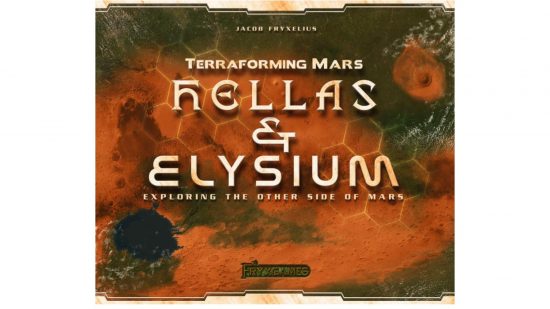The space strategy game Terraforming Mars by FryxGames has loads of expansions. There are plenty of boxes to choose between, and the right one for you will depend on what you want to get out of your Terraforming Mars expansion.
Some of the strategy board game’s expansions simply increase the amount of variety on offer, while others add to the complexity, introducing brand new mechanics. Then there are other boxes for this tile game that simply increase the amount of variety on offer.
Check out all the Terraforming Mars expansions below. Then why not check out our list of the best board games of all time.
| Expansion | Released | Main additions |
| Hellas & Elysium | 2017 | Two new maps with new milestones and awards |
| Venus Next | 2017 | Lots of new cards involving the planet Venus, a terraforming side objective |
| Prelude | 2018 | Prelude cards that speed up the early game |
| Colonies | 2018 | New moons to colonize and travel to with trade fleets |
| Turmoil | 2019 | A Martian government players can influence, Global events |
Terraforming Mars: Hellas & Elysium
Pros
- Cheap
- Tons of variety to shake up the meta
- Doesn’t add much complexity
Cons
- Elysium is fairly similar to the original map
- Doesn’t add much complexity
Hellas & Elysium is the first Terraforming Mars expansion ever released. It does exactly what a good first board game expansion should: provides a nice chunk of replayability to the base game.
As well as new milestones to go after and awards to win, the Hellas & Elysium expansion also comes with two new maps. Hellas shows the South Pole of Mars, and features a big crater to fill with water, greenery bonuses to the north rather than centre of the board, and tiles to the south which release heat when you construct on them.
Meanwhile, Elysium shows the other side of Mars. It has ocean spots to the north (and Olympus Mons, the biggest mountain on Mars), greenery around the equator like the base game board, and minerals to the south.
Fun awards and milestones include Estate Dealer on Elysium, which rewards placing tiles on ocean shores, and Polar Explorer on Hellas, which encourages building on the chilly pole.
Terraforming Mars: Venus Next
Pros
- Floaters add fun new strategies
- Interesting side project
Cons
- Makes the game longer
- Venus strategy can be very all or nothing
The second Terraforming Mars expansion leaves the red planet behind and moves on to a whole new globe. Well… not exactly. There’s not room for an entire new sphere on the board, so rather than a map, you have a Venus sideboard, with a few Venusian cities you can build, and a scale that shows the percent the planet is terraformed.
Terraforming Mars: Venus Next provides loads of new cards and five new corporations to enjoy, as well as an additional award and milestone. It also introduces a new resource to move around, called (try not to snigger) Floaters, which represent floating infrastructure on Venus (think Cloud City).
Venus cards gain you points, but don’t tie-in to the engine-building aspect of the game, making investing in the planet a tricky bit of risk-reward. This does tend to result in players ignoring the planet entirely, or going all in, however.
Venus is probably the least popular Terraforming Mars expansion, for a couple of reasons. The main complaint from Terraforming Mars fans is that the new cards dilute the deck, slowing down terraforming, and the game as a whole. To try and curtail the problem, Venus Next adds a new phase where the World Government automatically does some terraforming each turn. But it’s an imperfect fix.
Terraforming Mars: Prelude
Pros
- Makes the early game much more streamlined
- Cuts down overall play time
Cons
- Can be difficult for new players
- Some prefer starting from nothing
The highest rated Terraforming Mars expansion on BoardGameGeek, Terraforming Mars: Prelude is much loved for shortening the game’s overall length and making the most boring part, the start, more interesting.
As well as 35 ‘prelude cards’, there are also five new corporations and seven new projects in the box, just to provide a bit of extra spice.
The way Prelude works is pretty straightforward. You deal out four prelude cards, which give early game bonuses, to each player, and they choose two they want to keep, along with a corporation. It’s a simple change, but it gets things moving much more quickly. Once you start playing Terraforming Mars with Prelude, you’ll likely never want go back. Many fans consider it essential.
The only real downside to this expansion is that if you’re new to the game it can feel like jumping in the deep end, having to make important decisions which will dramatically impact your engine-building before you’ve even started. It’s one to bring to the table once everyone knows what they’re doing.
Terraforming Mars: Colonies
Pros
- New mechanics introduced in a simple, elegant way
- Colonies get more resources flowing, which makes the game faster
- Doesn’t add lots of extra complexity
Cons
- Does add a little extra complexity
While Venus Next brought in the planet one jump sunwards from Earth, Terraforming Mars: Colonies expands the Solar System still further with a bunch of moons to set up shop on.
While it adds new mechanics, has the usual smattering of corporations, and includes loads of new cards, Terraforming Mars: Colonies doesn’t actually add too much in the way of complexity to the base game.
Essentially Colonies provides two new actions. You can colonize a moon or planetoid and you can trade with one, either option providing bonuses and resources. The expansion also introduces more player interaction, since a player who colonizes a planet benefits from other players trading with them later.
The main thing Colonies has going for it when compared to Venus Next is that its mechanics feel more connected to the rest of the game. It only uses existing resources, so it gels with the game’s engine building. Plus, with more resources flying about in Colonies, you’ll terraform faster, and the game will end quicker!
One of the interesting things about Colonies is the expansion can provide a steady supply of rare resources like animals, opening up new strategies as otherwise niche cards are transformed into potential powerhouses.
Terraforming Mars: Turmoil
Pros
- Deeper player interaction
- A meaty expansion with fun mechanics
Cons
- High complexity
- Bit of a time sink
Terraforming Mars: Turmoil is the most complicated Terraforming Mars expansion there is, and one to go for only if you’re prepared for a real brain bender.
Thee expansion adds a Martian government with different factions and political parties that can come to power, and players must vie for influence – which adds lots of fun and competitive player interaction.
Global events add another wrinkle, with an event tracker that lets you plan for upcoming changes.
Overall, the new mechanics are really intriguing, but you need to be prepared for a more complex board game if you pick this box up.
If you like Terraforming Mars, you might be interested in the more streamlined spin-off variant Ares Expedition. Check out our Terraforming Mars: Ares Expedition review here to see our thoughts.
If you’re looking for more guidance when growing your board game collection, we also have guides to all the Dominion expansions, Wingspan expansions, and the best Carcassonne expansions.






